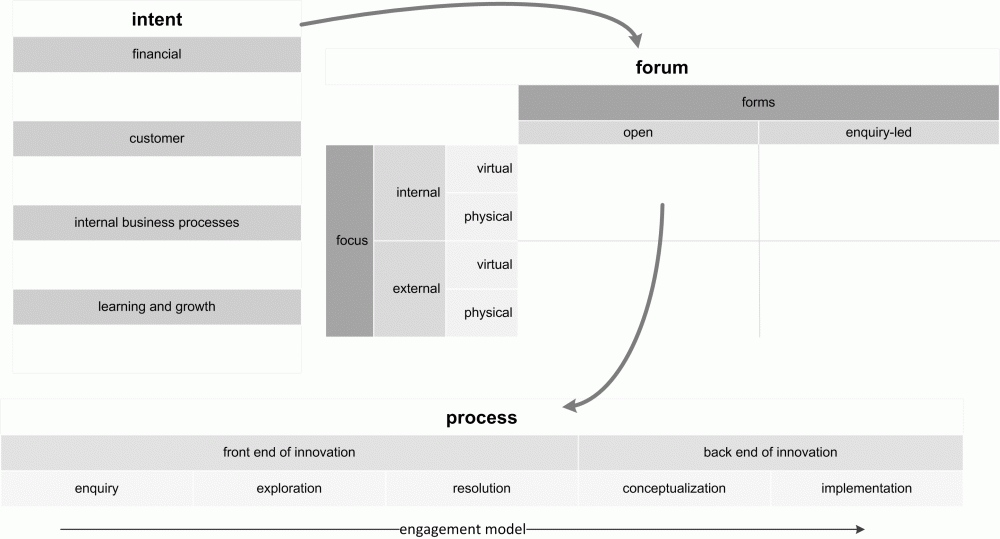By: Doug Collins
What does governing the practice of collaborative innovation mean? When we govern do we compromise the spirit of openness and experimentation that enlivens the practice? In this article innovation architect Doug Collins applies the blueprint for collaborative innovation to explore these critical questions. His view? Governance is guidance: helping people work to their potential.
I introduced the blueprint for collaborative innovation in a past article. The blueprint offers a simple, visual approach for depicting how your strategic intent maps to the forums where you apply the practice which in turn map to the mean by which you support a day in the life of a given campaign (figure 1).
Figure 1: the blueprint for collaborative innovation
The blueprint offers simplicity and clarity: powerful levers that we can pull as attention spans shrink. The blueprint serves, too, as a reference for our exploration of governance. I explore governance by its attributes of intent, forum, and process.
Governance of Intent
The depiction of intent shows where the organization envisions the practice of collaborative innovation will add value. The depiction of intent may address the goals for the whole organization (e.g., gain business from half the Fortune 500). The depiction may address a specific set of goals that support the larger intent (e.g., increase customer satisfaction amongst enterprise clients).
The key? Show how the practice ties to a critical business question for the organization.
The depiction itself is simply an application of the balanced scorecard as created by Robert Kaplan and David Norton. The scorecard works well because it, too, is a simple, visual approach.
Who governs intent? The senior management team.
No margin, no mission.
Specifically, the senior management team commits to setting and to helping the organization achieve metrics around the three levers that drive performance: profitability, asset utilization, and financial leverage. Organizations, both profit and non-profit, apply these metrics. A savvy executive at one of the largest charitable organizations in my home town observed to me: no margin, no mission.
In the context of collaborative innovation, the senior leader who commits to advocating for the practice joins the conversation to suggest where crowdsourcing may prove the most effective—and on what terms.
For example, imagine that the organization’s senior leaders decide they must acquire certain technologies and skillsets to complement and differentiate their offer to the customer. Consulting with the organization’s practice leader, they decide not to focus their enquiry on potential acquisition candidates. Whereas a question of this nature has the potential to excite the imagination of the organization, the downside of telegraphing intent to potential acquisition candidates makes this approach unworkable. Unwise.
Instead, the senior practice leader suggests a less overt approach that nevertheless goes to the heart of the matter…
What new capabilities, were we to offer them to our clients, would enable them to meet their goals in more effective, compelling ways?
The leadership team takes the acquisition option off the table. However, they anticipate that they may need to acquire capabilities outside the firm to realize the potential of some of the ideas that people contribute.
Further, the leadership team acknowledges that, as a group, they lack the level of intimacy with their clients to understand fully the value the organization could provide them. They value the perspective the crowd can offer (figure 2).
The two most powerful, governing actions that the leadership team takes relative to expressing intent are forming the critical question and convening the community upon it. From here, we move to the mechanics of the practice.
Figure 2: translating intent into the critical business question
Governance of Forum
Forum addresses: Where do we play? Do we create open space? Do we lead with an enquiry? Do we open the space or the enquiry outside the organization? Or, do we restrict engagement, internally?
Governance of forum rests with the senior leader who commits to helping the organization embrace the practice of collaborative innovation. This individual, along with their team of practice leads, determines the optimal playing field for the campaign team and their community.
For example, imagine that a campaign sponsor wishes to develop a capability that solves a problem for existing clients in a more effective way. If the organization has no track record of structured, externally focused ideation with clients (e.g., they have not vetted the IP implications of co-creating with clients), then the sponsor of the organization’s collaborative innovation program might suggest the campaign sponsor start by inviting the people within the organization who are closest to the customer to engage first—both to gain valuable insight and to rehearse for externally focused innovation that may come in time.
The person sponsoring the practice will be in the best position to offer this guidance because they will have experienced the greatest number of campaigns and, as a result, be in the best position to adjudge the campaign sponsors goals, relative to the organization’s readiness to pursue them across all four squares that comprise the forum.
In my experience, savvy practice sponsors cultivate relationships with the people in the organization who can help them engage on the external forms of innovation. These people may include their counterparts who govern the organization’s executive advisory boards and strategic marketing organizations, for example.
They have already paved the way to engaging clients and perhaps the market at large. The practice sponsor may find that the colleagues, in time, see value in the enquiry-led form of engagement that collaborative innovation offers their initiatives (figure 3).
Figure 3: governance of forum
Governance of Process
Process governance makes its influence felt in two ways: governance of the elements that comprise the campaign flow and governance as ideas move from the front to the back end of innovation.
For the former, the practice sponsor—typically a member of the senior leadership team—exerts governance by assigning a practice lead to assist the campaign sponsor develop the critical elements that comprise their activity, including question formation (if enquiry led), community definition, and ideation flow.
Governance comes in the form of consultative engagement with the campaign sponsor. The practice leads help the sponsor ensure that the elements, as they compose them, work towards the end goal for the campaign. The practice lead offers guidance on best practices, relative to the organization’s capabilities and competencies.
Governance is guidance: helping people realize their fullest potential.
The practice sponsor, along with the campaign sponsor, governs the flow of idea as they develop from the front to the back end of innovation. The practice sponsor may involve other members of their senior leadership team, as well.
Governance in this instance serves as an exercise in ensuring the organization has a way to explore ideas that do not fall neatly into the current structure.
Typically, a collaborative innovation campaign will generate ideas that the campaign sponsor assesses they can pursue under their own charter and ideas that, while compelling for the organization at large, go beyond the campaign sponsors ability to pursue them under their own power. Governance in this instance serves as an exercise in ensuring the organization has a way to explore ideas that do not fall neatly into the current structure.
Indeed, the first organization that gets disrupted by an authentically novel idea is the organization in which it was conceived.
Practically speaking, pursuing an idea to concept may demand a significant outlay of funds. For example, a contributor develops an idea around a new retail concept. Who will pay to test its potential in a Des Moines storefront for four months?
My guidance here is to challenge mindsets, not budget. That is, if marketing has, for the past 100 years, tested new retail concepts, then the senior leader for marketing should govern the testing of this particular concept. At the same time, the shift in mindset that occurs: ideas may come from other parts of the organization as a result of the introduction of the practice of collaborative innovation (figure 4).
Figure 4: governing process–moving from the front to the back end of innovation
Parting Thoughts
In the Digital Age, the social business exists to help people work to their fullest potential and to express leadership. I see this transformation occur in each organization and with each client that I serve.
In this environment, governance becomes guidance: helping people explore their potential within the structure of an organization geared to serve customers in a way that the latter values. Transparency, relative to intent, forum, and process, becomes the order of the day.
By Doug Collins
About the author:
 Doug Collins is an Innovation Architect who has specialized in the fuzzy front end of innovation for over 15 years. He has served a variety of roles in helping organizations navigate the fuzzy front end by creating forums, venues, and approaches where the group can convene to explore the critical question. As an author, Doug explores the critical questions relating to innovation in his book Innovation Architecture, Practical Approaches to Theory, Collaboration and Implementation. The book offers a blueprint for collaborative innovation. His bi-weekly column appears in the publication Innovation Management.
Doug Collins is an Innovation Architect who has specialized in the fuzzy front end of innovation for over 15 years. He has served a variety of roles in helping organizations navigate the fuzzy front end by creating forums, venues, and approaches where the group can convene to explore the critical question. As an author, Doug explores the critical questions relating to innovation in his book Innovation Architecture, Practical Approaches to Theory, Collaboration and Implementation. The book offers a blueprint for collaborative innovation. His bi-weekly column appears in the publication Innovation Management.




